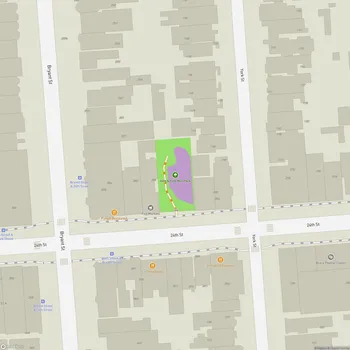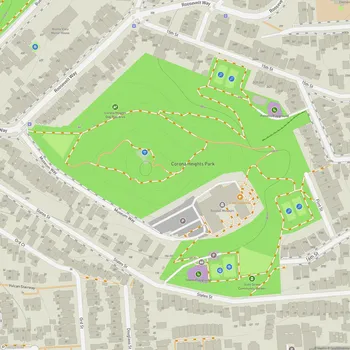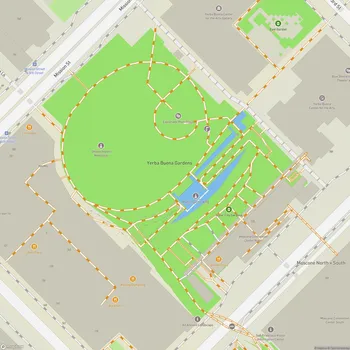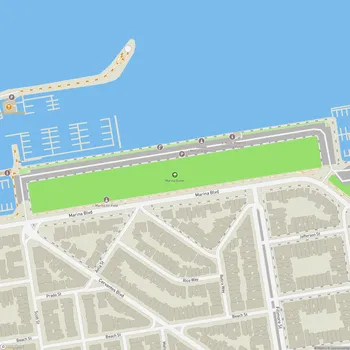Lafayette Park
Interactive Park Map
About Lafayette Park
Sweeping Views from a Pacific Heights Perch
Found in San Francisco's elegant Pacific Heights neighborhood, Lafayette Park sprawls across 11.49 acres of hilltop heaven. Established back in 1867, this urban retreat covers four city blocks between Washington, Sacramento, Gough, and Laguna Streets.
The park's elevated position rewards you with some seriously jaw-dropping views of the city. Find a good spot and you can take in the Marina district, Alcatraz Island, San Francisco Bay, Buena Vista Park, and Twin Peaks all in one panoramic sweep. If you can time your visit for sunset, you're in for a special treat as the city lights begin to twinkle below.
A Park with Drama in Its Past
Lafayette Park's history reads like a 19th-century legal drama. Attorney Samuel W. Holladay claimed ownership of what's now the eastern half, even building his mansion right at the hill's summit.
What followed was a 70-year legal tug-of-war with the city that wasn't resolved until 1935, when San Francisco finally purchased the remaining Holladay property. Talk about a committed litigant!
Two Parks in One
You can actually see the park's split history in its landscape. Wander through the western section and you'll notice a formal, symmetrical 19th-century design with orderly pathways.
Cross to the eastern half, developed during the Works Progress Administration days of the 1930s, and the vibe shifts to something more natural and less structured, with denser vegetation. Many impressive trees - Eucalyptus, pine, cypress, elm, and palm - still stand as living relics from the original Holladay estate.
Keep your eyes on the treetops and you might spot the park's most colorful residents: a flock of wild parrots that have made Lafayette Park their home. These bright birds have become local celebrities in their own right.

Something for Everyone
Whether you're looking to break a sweat or just chill out, Lafayette Park has options for both. The tennis courts attract players of all skill levels, while the generous grassy areas provide perfect spots to spread out a blanket, read a book, or simply soak up some sunshine.
Got kids? The modern children's playground features multiple structures, slides, and climbing features with safety-conscious padded surfaces. It's thoughtfully divided into sections for different age groups, making it a hit with families.
Dog parents haven't been forgotten either. The designated dog park area allows your four-legged friends to run off-leash while you chat with fellow pet lovers. There are dog-height water fountains and plenty of space for pets to burn off energy.
A Fresh Face for a Historic Space
In 2013, Lafayette Park got a major facelift thanks to the 2008 Clean and Safe Neighborhood Parks Bond. The $10 million renovation project didn't just spruce things up - it completely enhanced the visitor experience.
One notable improvement was the addition of an accessible path connecting the playground to a summit picnic area with views of Alcatraz and the Bay. The renovation also brought clean, well-maintained restrooms and multiple picnic areas with tables and benches across the park - practical touches that make longer visits much more comfortable.
From Stargazing to Sanctuary
Here's a fun fact: In 1879, Lafayette Park hosted the West Coast's first astronomical observatory, built by scientist George Davidson. Imagine the stargazing sessions that must have happened here!
The park also served a crucial role after the devastating 1906 earthquake, becoming a refuge for displaced residents. From this elevated position, people watched as the great fire spread through their city below.
Today, Lafayette Park remains a neighborhood space where history, recreation, and natural beauty coexist on this scenic hilltop.
All Features & Facilities
Active Recreation
Nature & Wildlife
Visitor Services
Food & Gathering
Photo Gallery (click to enlarge)

ParkMagnet Score
Good Park
Park Size
Opening Hours
Weather
Top Restaurants Near Lafayette Park
Pistachio Kitchen Restaurant & Espresso Bar
0.2 miles1535 Franklin St, San Francisco, CA 94109
Comfortable breakfast and brunch spot serving excellent fresh food with exceptional service and great coffee.
Himalayan Cuisine SF
0.3 miles1412 Polk St, San Francisco, CA 94109
Authentic Nepalese and Indian restaurant serving flavorful dishes with attentive service and warm hospitality.
Rise & Set
0.3 miles1247 Polk St, San Francisco, CA 94109
Modern breakfast and brunch spot featuring creative dishes like Thai French toast and flavorful benedicts.
Top Hotels Near Lafayette Park
Kimpton Hotel Enso
0.3 miles1800 Sutter St, San Francisco, CA 94115
Stylish Japanese-inspired hotel featuring modern rooms, an on-site restaurant and bar, plus complimentary wine hours.




